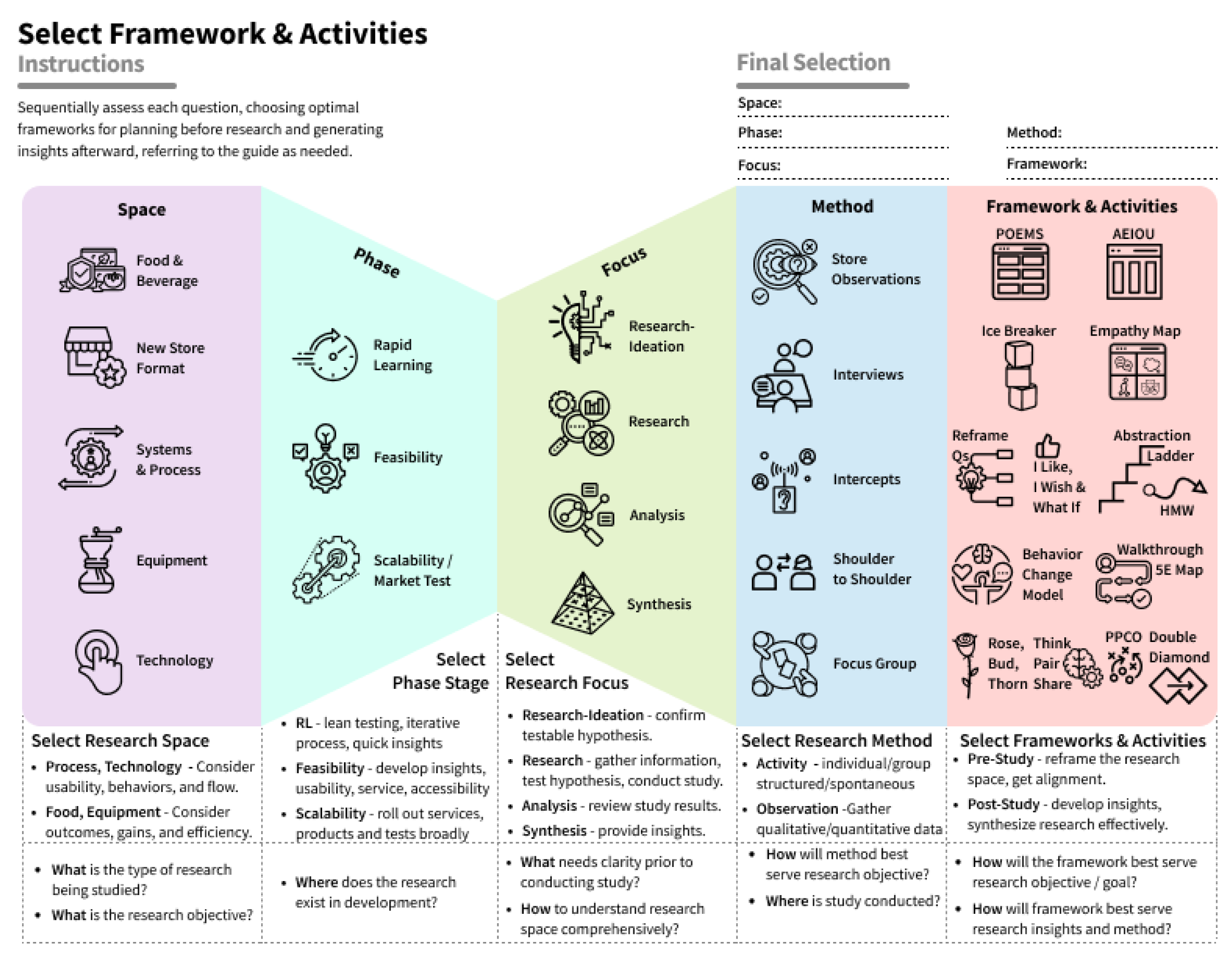Starbucks Select Toolkit
Starbucks was our project partner for an Innovation Methods project geared towards revamping their research methods.
SETTING
Starbucks' transformation unit, tasked with evaluating the feasibility and scalability of R&D innovations, aims to improve its research approach.
Starbucks Transformation Unit
+

In order to determine which innovations will stick, extensive and intensive field research is required.
The transformation unit, charged with validating the scalability of R&D innovations from service systems to new food tech, faces the challenge of conducting comprehensive field research.
Collaborating with the Institute of Design's Innovation Methods class, the transformation unit partnered with our team Venti Visionaries.
USER NEED
To test and validate effectively, the transformation unit must understand design research methods, tools and frameworks and when to use them.

ddddddddddddddd
Becoming Proficient at Design Research
To achieve its research objectives, the transformation unit must possess a robust understanding of design research methods, tools, and frameworks.
This proficiency is essential for the transformation unit's ability to navigate complex data and translate it into actionable insights, thus bridging the gap left by the lack of a formalized qualitative research process.
BARRIER
The transformation unit had diverse skills but struggled with a lack of a common research strategy and uncertainty about which methods to use when.

ddddddddddddddd
While the team benefited from a variety of backgrounds, it lacked a unified approach to research.
Only some were familiar with research techniques, and those that were familiar were not entirely sure what methods to use when.
The transformation unit’s lack of standardized training and guidance on design research tools is compounded by their scattered workforce and varied methods, due to differences in design and research experience.
This absence of a unified educational framework significantly hampers their ability to effectively and efficiently utilize design research tools, creating a pressing need for streamlined processes that clearly outline the application of specific methodologies for achieving optimal research outcomes.
DESIRED STATE
The transformation unit aims to optimize design research and democratize the use of HCD methods, establishing itself as a learning and feedback hub to elevate innovation standards across Starbucks.

ddddddddddddddd
Streamlined Training and Improved Research Analysis on the Horizon
The transformation unit upon achieving a uniform understanding of these tools, both seasoned researchers and novices will navigate field research with greater ease, leading to smoother testing procedures and more insightful analyses.
The integration of a coherent educational program will ensure rapid onboarding for newcomers, fostering a cycle of continuous improvement and innovation.
SOLUTION
Introducing Starbucks Select: a streamlined toolkit for field research, designed to enhance learning and sensemaking within the transformation unit by addressing gaps in research education and experience.

The Select Framework and Activities tool guides users to appropriate research methods and frameworks based on the research objective, stage, and focus.
Empowering Teams with Structured Frameworks for Effective Research
The Venti Visionaries team responded with "Starbucks Select," a design research sensemaking toolkit. It equips Starbucks to match research tools with objectives systematically, fostering efficiency and a shared understanding that paves the way for innovation.

The Understand Frameworks and Activities tool offers descriptions, best uses, and goals for frameworks and visually aligns them with their most common phase, focus, and method.
1.2 T
1.2 Trillion digital photos are taken every year. That's an average of 160 for every single person on planet Earth.
4M+
Cult fave VSCO, the #1 photo editing app loved by Gen Z and teenagers worldwide, has over 4 Million paid users.
85%
Of all photos taken, about 85% are taken with smartphones, edging out traditional photography by a long shot.

Photographers can showcase their skills by upload portfolio images and creating galleries.

When a client is requesting a session, the photographer can see where the job is and decide whether to accept or decline.

Shows the transactional details of prior jobs, including the time duration, money spent and photos taken.
USER FEEDBACK
Part of my design process included conducting market research and surveys of people who are the intended users for the app. Below are some of their response and how I used their feedback to improve the design:

“I would like to see portfolios of the photographers inside the app.”
I included browseable galleries to enable photographers to show off their best work. This complements the original idea to include a link to their Instagram profile.
“Add a rating system where people can rate the experience of the person they hired.”
I added a rating and review functionality so that photographers and subjects can mutually rate each other, similar to Uber, encouraging professionalism from both sides.

Photographer Side
clickable prototype
Client Side
clickable prototype
Photographer Side
Customer Side